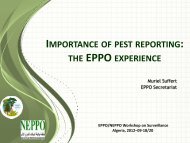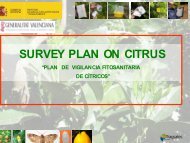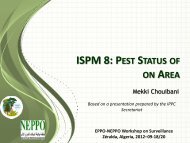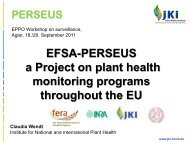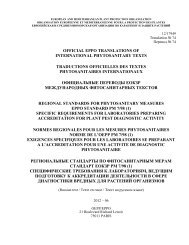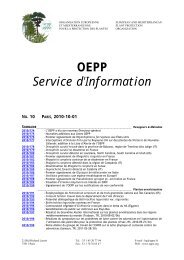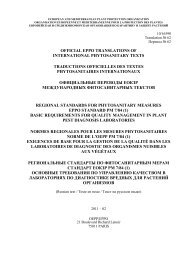EPPO Reporting Service - Lists of EPPO Standards - European and ...
EPPO Reporting Service - Lists of EPPO Standards - European and ...
EPPO Reporting Service - Lists of EPPO Standards - European and ...
Create successful ePaper yourself
Turn your PDF publications into a flip-book with our unique Google optimized e-Paper software.
<strong>EPPO</strong> <strong>Reporting</strong> <strong>Service</strong> – Pests & Diseases<br />
North Dakota State University, Extension <strong>Service</strong>. Knodel JJ, Charlet LD, Gavloski J (2010) Integrated<br />
Pest Management <strong>of</strong> sunflower insect pests in the Northern Great Plains.<br />
http://www.ag.ndsu.edu/pubs/plantsci/pests/e1457.pdf<br />
Manitoba Agriculture, Food <strong>and</strong> Rural Initiatives. Sunflower maggots.<br />
http://www.gov.mb.ca/agriculture/crops/insects/fad41s00.html<br />
University <strong>of</strong> Guelph (CA). Paiero SM, Marshall SA, Pratt PD, Buck M (2008) The insects <strong>of</strong> Ojibway<br />
Prairie, a southern Ontario tallgrass prairie.<br />
http://www.uoguelph.ca/debu/Insects_Of_Ojibway_Species_List_2008.pdf<br />
University <strong>of</strong> Guelph (CA). Smith S, Wukasch RT (2007) Sunflower maggot. Strauzia longipennis<br />
(Diptera: Trypetidae). http://www.uoguelph.ca/pdc/Factsheets/PDFs/100SunflowerMaggot.pdf<br />
<strong>EPPO</strong> RS 2011/037<br />
Panel review date - Entry date 2011-02<br />
2011/038 Situation <strong>of</strong> Rhagoletis completa in France in 2010<br />
As reported in <strong>EPPO</strong> RS 2008/138, Rhagoletis completa (Diptera: Tephritidae – EU Annexes)<br />
was reported for the first time in South-Eastern France on walnut trees (Juglans regia) in<br />
2007. In 2009 <strong>and</strong> 2010, R. completa was also detected in South-Western France, as well as<br />
in the northern part (<strong>EPPO</strong> RS 2010/182). A national survey was conducted in 2010 to<br />
determine the extent <strong>of</strong> the pest spread. As a result, the presence <strong>of</strong> R. completa was<br />
confirmed in the following regions (<strong>and</strong> departments):<br />
South-East<br />
- Languedoc-Roussillon (Aude, Hérault, Gard)<br />
- Provence-Alpes-Côte d’Azur (Alpes de Haute Provence, Bouches du Rhône, Hautes-<br />
Alpes, Vaucluse)<br />
- Rhône-Alpes (Ardèche, Drôme, Isère, Rhône, Savoie)<br />
South-West<br />
- Aquitaine (Dordogne, Gironde, Lot-et-Garonne)<br />
- Midi-Pyrénées (Gers, Haute-Garonne, Lot, Tarn-et-Garonne, Tarn)<br />
North<br />
- Alsace (Bas-Rhin, Haut-Rhin)<br />
- Ile-de-France (Essonne, Hauts de Seine, Seine Saint Denis, Yvelines)<br />
The situation <strong>of</strong> Rhagoletis completa in France can be described as follows: Present, first<br />
found in 2007 in Rhône-Alpes; it then spread to several regions (Alsace, Aquitaine, Ile<br />
de France, Languedoc-Roussillon, Midi-Pyrénées, Provence-Alpes-Côte d’Azur, Rhône-<br />
Alpes).<br />
Source: NPPO <strong>of</strong> France (2010-12).<br />
Additional key words: detailed record Computer codes: RHAGCO, FR<br />
2011/039 Situation <strong>of</strong> Ips duplicatus in the Czech Republic<br />
Until the beginning <strong>of</strong> the 20 th century, Ips duplicatus (Curculionidae, Scolytinae - EU<br />
Annexes) occurred only in the Euro-Siberian taiga from Sweden to the Sakhalin Isl<strong>and</strong> <strong>and</strong><br />
in the Alps. During the subsequent decades the pest has exp<strong>and</strong>ed its range to Central<br />
Europe (e.g. Czech Republic, Pol<strong>and</strong>, <strong>and</strong> Slovakia). In the Czech Republic, the insect was<br />
first recorded in the 1920s <strong>and</strong> outbreaks have been reported since the 1970s in the North-<br />
East. Monitoring surveys with pheromone traps were carried out from 1997 to 2009 in state<br />
forests <strong>and</strong> showed that I. duplicatus now occurs practically across the whole territory <strong>of</strong><br />
the Czech Republic, mainly on spruce (Picea abies). The numbers <strong>of</strong> insects caught<br />
fluctuated over time (low populations were observed in 2002 <strong>and</strong> a peak was observed in<br />
10







